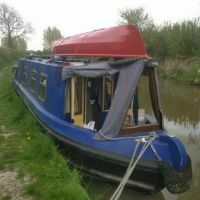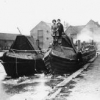

Steve King
Member-
Posts
113 -
Joined
-
Last visited
Profile Information
-
Occupation
River Trips Proprietor
-
Boat Name
Liberty Belle
-
Boat Location
Ely (summer) Upware (winter)
Recent Profile Visitors
2,738 profile views
Steve King's Achievements
Contributor (4/12)
0
Reputation
-
Excellent, thank you. Is the fleet number of Bootes (or whatever boat is was) is stamped on the funnel somewhere? GUCCCo put the fleet number on many parts of the boats I believe. At Camden Lock back in the '70s were some stands from the hold of a Town class boat which had fleet numbers on them (wish I'd noted them down ) Isn't it remarkable that we can sit at home (or wherever) in front of a computer, correspond in this way and verify history. Steve
-
Were GUCCCo motor boats originally fitted with chemical toilets in their engine rooms? A summary of the discussion so far, a plea for ideas, and a startling observation (!): Elsan have been making chemical toilets since the 1920s. Elsan fluid was different in those early days, and Jeyes fluid was an alternative. An early type of toilet is recalled which had a vent pipe rising from the rear of the closet in which a removeable inner container was installed. Several contributors remember seeing plans of the boats which showed how such a facility had been designed, and might have been installed. The plans depicted a closet with a vent, from which lightweight metal piping was routed to the engine room roof in way of the original ‘liner’ funnel, presumably to release to atmosphere any unpleasant smells, gases or condensation. The decision to fit such a facility would have been taken by company management and/or the boat designers and would have been in keeping with the modern image of the fleet. Although probably unknown to canal boatbuilders, chemical toilets would have been readily available to H&W and Yarwoods via ships chandlery catalogues. Photographic evidence has been found to show what is obviously a vent on the roof of motor boat Pinner, being in the predicted location and complete with pipe poking up through the fitting. Many ex-GUCCCo motor boat roofs have been plated over in this location, obviously having been similarly fitted in the past. Set against this is that no-one recalls seeing such a facility installed in a motor boat and there is doubt that they ever were. The boatmen would probably not have seen the need for such a sophisticated and sizeable item, preferring to use a bucket in the time-honoured way and to empty it overside immediately after use without the need for chemicals. The closet would have taken up valuable space in the engine room. The piping might have been superfluous as the ventilation in the engine space was good anyway. Besides, there were no emptying points for chemical toilets along the canals at that time. But if that was the case, what was that fitting on the roof for? If it was for removing hot air from the engine room up the liner funnel why did it have an inner pipe, and besides, wouldn’t the pigeon box and the engine room doors have been more effective for this purpose than a small hole in the roof? Did the fitting then ventilate something other than a toilet? The gases from the battery while it charged on its small shelf at the back of the engine room? The engine room bilge? Probably not, as this is modern day practice. I can’t think of anything else that might possibly have needed ventilation. Ideas anyone? In lieu then of any superseding reason for providing that fixture on Pinner’s engine room roof, I would advance with a degree of certainty a case that many (perhaps all) GUCCCo motor boats were fitted with a chemical toilet installation in the engine room from new. The boatman may not have wanted them, there may not have been anywhere to empty them, they may not have been installed for very long – but when the boats were delivered they were there. Further, I would propose that the chemical toilet was in fact the very reason for providing a ‘liner’ funnel rather than the conventional tubular pipe, so as to provide not only for exhaust gases, but toilet ventilation too. Steve PS Does anyone have photos or details of that surviving original liner funnel to share please?
-
That's a tall order Alan, given the relative dearth of photos of working narrowboats (compared to, say, steam locomotives) to ask for chapter and verse on a chemical toilet of the 1930s Nothing in the two GUC promo books anyway. I purchased a chemical toilet from the then well-known Thomas Foulkes in E17 when I bought Royalty 'Duke' in 1978. The chap behind the counter joked with me that it wasn't often that you could obtain full sanitary accomodation for three pounds fifty. It was, as you note, a heavily-galvanised ribbed 'drum', with a wire handle complete with wooden roller, and a nice one-piece wooden seat. A small container of Elsan Blue completed the facility. There was no provision for a vent pipe, nor, as I recall, any lid. The chemical toilet in the GUCCCo motor boats was as I recall (from the plans I saw many years ago) situated on the port side of the boat. As someone else observed, chemical toilets of that era were chambers in which was installed the bucket, and a vent pipe would have been provided to the chamber, not the bucket. It would have been quite a simple matter to clip the lightweight piping to the angle-iron of the engine room and route it to the liner funnel where the exhaust went out. Neat and convenient. Perhaps the exhaust gases would draw out any noxious smells. I think to dismiss the idea because of a lack of emptying points is to miss the point that these were modern craft with electric light and high speed diesel engines, and one can imagine someone saying "but surely you need to provide a toilet, this is 1935?". Then it was a matter of understanding that the trips only lasted three or four days and the bucket would last that long, and if it didn't there was always the entrenching tool (folding shovel) that was the norm in the early days of hire boats for digging a hole in the canal bank and tipping in the contents of the toilet. It might be frowned upon now, but it was the norm in the 1950s and 60s. Steve
-
Thanks Liam. It's even clearer here at 25:56 than in the previous frame. We see the flange of the engine exhaust as the forward of the two fittings, with beyond it a stub pipe affixed to the engine room roof and complete with an inner pipe poking through. If it was merely a vent for the engine room (and why would that be required with a pigeon box adjacent?) it would not have a pipe through it. This clearly shows that something remote, and linked by pipework, is being vented - the chemical toilet. Steve
-
As further evidence I would offer the following video. Pause it at 3m 40s to see the two outlets on the engine room roof of 'Pinner', one for the exhaust and one for the chemical toilet. The boat sounds as if it has the National engine still so it's doubtful that the fitting is a leftover from a previous engine with a different outlet. Steve
-
I recall that back in the early 1990s (or thereabouts) Germany sent over a small sea-going inspection vessel which moored on the River Thames in central London as part of a water quality survey. The tv reporter commented that it could have had a better name for this task as the camera revealed it to be named MV PIDDER LING. Steve
-
Now that would be telling, but what I would say is watching that one shows some of the scenes (in 2008) which are depicted in the archive movies. Some questions: Can anyone identify the butty with Perseus? Where is the 'warehouse' with cabin cruisers inside? Banham's of Cambridge would be my guess, but a guess is all it would be. Is that 'Shellfen' the ex Dutch tanker barge being shafted along? Steve
-
I've just stumbled upon these superb videos on YouTube. Mainly of the River Great Ouse but also some of the canals with working narrowboats in evidence. Highly evocative stuff with good background music too, so have your sound 'on'. Five videos in total from the same source, all good but especially the last four: Now all we have to do is identify the locations and the boats ! Laurence, this deserves to be a commercial release in your catalogue doesn't it? Steve Edited to add that GUCCCo fleet no 70 is 'Perseus' and a boat I've steered many times as a waterbus, but never thought I'd see it carrying cargo.
-
Good point, I went from Ely to Upware last week and saw none at all. And we had the first floating masses that I'd seen pass through Ely last year, the ducks consumed the first batch completely but subsequent ones did lodge in places and might have spread by now. EA did treat and remove it at the end of last season mind, so perhaps they are responsible for its absence? Steve
-
You may already have I'm afraid, I called my second speedboat TYRO back in the mid 1990s. It had been FAB 2 but I tired of that. I'm surprised more people haven't come up with the name, although it was diffcult to get over to Woolwich Radio on the vhf when we went down through the Thames Barrier, many have never heard the word it seems. Steve
-
Is it a Springer? I knew the family who owned such a boat built in 1970 to replace their small cabin cruiser 'Tillykins'. They moored it at Cosgrove on the Grand Union. The owners were Stan and Barbara Cooper of St Albans, now both deceased I believe. Their son Steve Cooper inherited the boat and probably kept it on the same mooring. It had a Lister SR3 air cooled engine, saloon at the front with demountable double berth, catalytic gas heater, galley and further berths aft. Cruiser stern. A rather unmemorable colour scheme in all-over grey or somesuch. I had a holiday on Barbie when the boat was almost new from Cosgrove one very cold winter (1971?) when we encountered ice at Brinklow and decided to turn back. I might be able to get you in touch with Steve Cooper if it is the boat you enquire about. Steve
-
My friend Rob has had his prized military motorbike stolen from outside his house in Oxley, Wolverhampton, just a few days ago. He suspects the local youth as being the culprits, and believing that they willl not be able to get it started he thinks that it may well get dumped in the canal nearby. If anyone spots it then, could they please let me know? Many Thanks. Steve
-
I'm sorry to have to disagree with you Pete, but I have definitely seen plans of an engine room equipped with a chemical toilet that had a pipe running from the back (I think) of the unit to a corresponding vent on the engine room roof immediately forward of the engine exhaust. And as I said, Southern Cross had evidence of such twin fittings, both of which would have made use of the original 'liner' funnel fitted when the boat was new. I admit that I was never able to discern the routing of the pipework, although I did look for evidence of it. I would concede that the boatmen would probably have seen little sense in this new-fangled intrusion into the engine room and that it might quickly have been dispensed with, but that doesn't mean that GUCCCo (or the Public Health authorities) didn't see having a 'proper' toilet in these modern boats as part of the equipment of that time, along with an electric headlamp and a high speed (sic) diesel engine. There were doubltless other applications for chemical toilets around that time so some kind of fluid was surely available. The boatmen would simply have emptied the whole 'bucket' into the canal when it was full. When the liner funnels were eventually replaced by the familiar tall (or short) pipe perhaps by then the chemical toilet had been removed through lack of use and the vent hole was simply plated over. I am surprised that the 'vent' hole in Chertsey's roof is not on the centreline of the roof, as per the exhaust outlet nearby, and I wonder therefore if it was for yet another exhaust outlet. Perhaps the chemical toilets were only fitted to the Star Class boats? Laurence, can you come up with any GUCCCo plans that would shed any light? Steve
-
The ventilation hole being for the chemical toilet, which had a vent pipe run from it at its location at the rear engine room bulkhead to the fitting on the roof - if I recall correctly from some plans I saw back in the 1970s. And thus any odour from the toilet was vented up the liner funnel, perhaps encouraged skywards by the engine exhaust in some sort of venturi principle. Or at least, that must have been the plan. Alternatively, given a low bridge or a tunnel the downdraught might have filled the toilet with exhaust fumes, doubtless to the consternation of whoever was trying to use it at the time. Have no boatmen passed down stories of this over the years, I've never heard any? Small Woolwich motor Southern Cross certainly had evidence of these two plated-over holes in the engine room roof when I owned the boat 30 years ago. Steve
-
http://www.bbc.co.uk/programmes/b00sjm1w Steve




